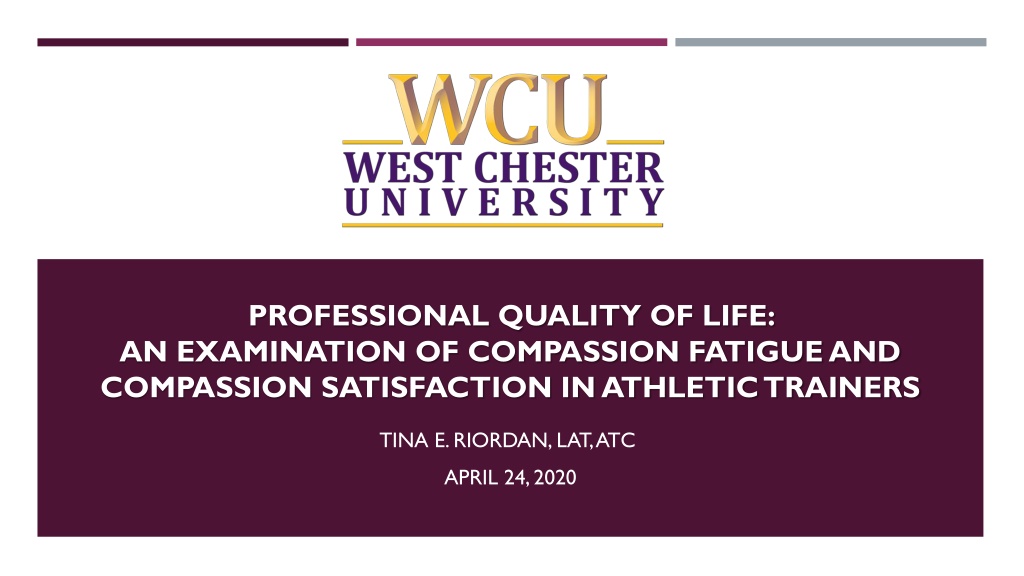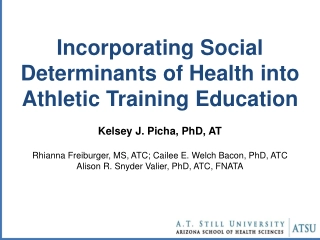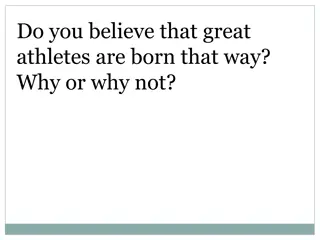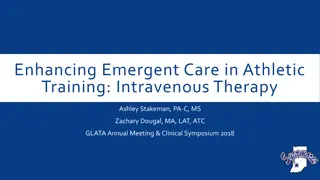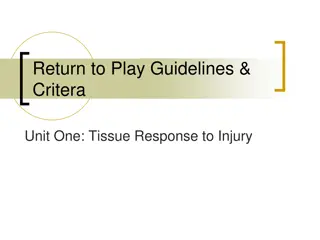Professional Quality of Life in Athletic Trainers
Delve into the world of athletic trainers to explore compassion satisfaction, compassion fatigue, and their impact on overall professional quality of life. Learn about the unique challenges and rewards faced by these dedicated professionals as they navigate the complexities of their roles.
Download Presentation

Please find below an Image/Link to download the presentation.
The content on the website is provided AS IS for your information and personal use only. It may not be sold, licensed, or shared on other websites without obtaining consent from the author. Download presentation by click this link. If you encounter any issues during the download, it is possible that the publisher has removed the file from their server.
E N D
Presentation Transcript
PROFESSIONAL QUALITY OF LIFE: AN EXAMINATION OF COMPASSION FATIGUE AND COMPASSION SATISFACTION IN ATHLETIC TRAINERS TINA E. RIORDAN, LAT, ATC APRIL 24, 2020
THESIS COMMITTEE MEMBERS Chairperson Lindsey Keenan, PhD, LAT, ATC Committee Members Emily Duckett, MS, LAT, ATC Alison Gardiner-Shires, PhD, LAT, ATC
COMPASSION SATISFACTION The positive aspect of helping Pleasure and satisfaction derived from recognizing impact of client change (Radey & Figley, 2007) Cornerstone of quality healthcare Job satisfaction influences the outcome of patient care and quality of work (Singh, 2017; Stamm 2010) Impacts career outcome, health, and personal relationships with co-workers
COMPASSION FATIGUE The negative aspect of helping The physical, emotional, and spiritual fatigue or exhaustion that takes over a person and causes a decline in his or her ability to experience joy or to feel and care for others (Worley, 2005) CF is connected to the relationship between the healthcare provider and the patient (Aycock & Boyle, 2008; Sabo, 2011) Professions that fit the definition of a first responder are at an especially high risk for CF (Bellolio et al., 2014; Boyle, 2011; Lombardo & Eyre, 2011).
WHAT ABOUT ATHLETIC TRAINERS? Compassion Satisfaction Words that describe the profession: Unique, dynamic, fun, fulfilling, connectedness, growing, dedication, challenging, caring, and important (Benes, 2015) Burnout AT s experience burnout through: role conflict, high time commitment, limited opportunities for career advancement, low salary and poor working conditions (Capel, 1990) Secondary Traumatic Stress There were 120 sports-related deaths of young athletes in 2008-2009; 49 in 2010; 39 in 2011; 33 in 2012, 32 in 2013 (NATA) More than 1.35 million children were seen in an emergency department for sports-related injury in 2012(Ferguson, 2013)
PURPOSE The purpose of this study is to examine the professional quality of life among athletic trainers, including compassion fatigue and compassion satisfaction
RESEARCH QUESTIONS AND HYPOTHESES 1. What is the prevalence of compassion fatigue in clinically-active athletic trainers? Athletic trainers experience a average level of compassion fatigue. 2. What is the prevalence of compassion satisfaction in clinically-active athletic trainers? Athletic trainers experience a high level of compassion satisfaction. 3. What is the relationship between the components of the Professional Quality of Life and years of athletic training experience? There will be a positive relationship between compassion fatigue and years of athletic training experience. There will be a negative relationship between compassion satisfaction and years of athletic training experience 4. Is there a difference in the components of the Professional Quality of Life between athletic training settings? There will be a difference in compassion fatigue between athletic training settings 5. Is there a relationship between the Professional Quality of Life components in clinically-active athletic trainers? There is a negative relationship between compassion fatigue and compassion satisfaction in athletic trainers.
METHODS INSTRUMENTATION: 2 Part Survey 3,000 certified athletic trainers whom maintained an active National Athletic Trainers Association (NATA) membership were invited to participate Demographics ProQOL- 21 293 certified athletic trainers Mean age 33.08 9.21 66.6(n = 195) female 33.4% (n = 98) male Response rate:10.8 %
DEMOGRAPHICS ETHNICITY/RACE GENDER Male Female White Ethnicity: 87.7% YEARS OF EXPERIENCE Years of Experience EMPLOYMENT SETTING Employment Setting Secondary Schools Elite Athletics Clinic/Hospital Non-Traditional N (%) N (%) 158 (53.9) 72 (24.6) 37 (12.6) 26 (8.9) 1-5 84 (28.6) 6-10 140 (47.8) 11-20 46 (15.6) 21+ 23 (7.4)
RESULTS Prevalence of Compassion Satisfaction and Compassion Fatigue Among Athletic Trainers Compassion Fatigue Compassion Satisfaction Levels of CS N Frequency Levels of CF N Frequency Low 0 0.0 % Low 31 10.6 % Average 14 4.8 % Average 150 51.2 % High 279 95.2 % High 112 38.2 %
RESULTS Relationship between CF and years of experience in clinically- active athletic trainers The relationship between these two variables showcased a significant, weak, negative correlation. r = -.182, n = 293, p = .002. Relationship between CS and CF scores The relationship between these two variables indicated a significant, moderate, negative correlation. r = -.400, n = 293, p = .000.
Athletic Trainers experience high satisfaction in their clinical compassion when providing care to patients. Similar findings in previous conducted studies (Cavanagh et al, 2019) Years of experience may influence compassion fatigue levels DISCUSSION Consistent findings within other health care professions (F. Cocker & N. Joss, 2016; Salmond et al, 2017) Relationship between compassion satisfaction and compassion fatigue interventions directed toward increasing compassion satisfaction may also decrease compassion fatigue (Fahey & Glasofer, 2016)
LIMITATIONS AND FUTURE RESEARCH Limitations Future Research Further validation of the ProQOL-21 tool Longitudinal study over the course of athletic trainers careers Mixed methods approach Interviews Explore other factors that may have a relationship with CS and CF Future research may have the opportunity to enhance the positive aspects of athletic trainers ability to care, and minimize the negative effects that may be experienced through this profession. SELF-REPORT MEASURE RESPONSE BIAS SMALL SAMPLE SIZE UTILIZATION OF A NEWLY ESTABLISHED ASSESSMENT TOOL
CONCLUSION Athletic trainers experience both compassion satisfaction and compassion fatigue due to their caregiving role. Additional research is warranted to further investigate this relationship in athletic training and examine both prevention and causes of compassion fatigue.
